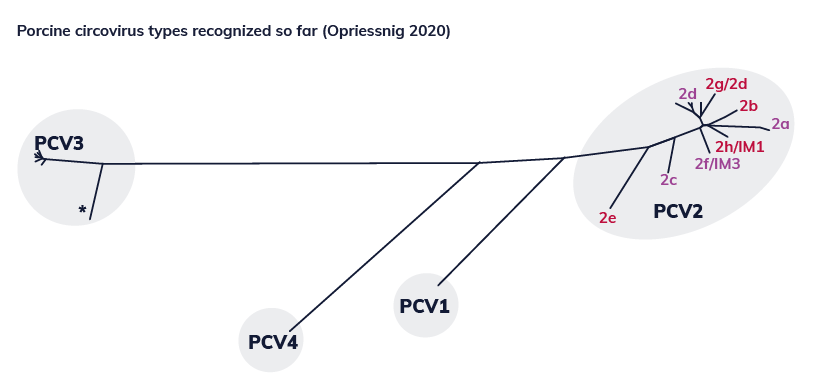PCV2
Porcine Circovirus (PCV2) infections
Porcine circovirus type 2 (PCV2) is ubiquitous in almost all pig herds worldwide. The discovery of the virus was associated with the initial findings of postweaning multisystemic wasting syndrome (PMWS) in piglets. The disease was first observed in Canada in 1991 as an undiagnosed wasting disease with high postweaning mortality. The new syndrome was characterized by loss of weight, respiratory distress and pale skin with typical pathological findings such as lymphadenopathy, interstitial pneumonia and hepatitis. The name PMWS with the detailed description of the syndrome was published in 1996. As the cause of the disease a genetically and antigenically distinct porcine circovirus was described and designed as PCV type 2 in 1998.
In contrast to PCV2, the PCV type 1 which was isolated earlier is considered nonpathogenic and was found in pig population with no signs of disease. Porcine circovirus type 2 (PCV2) was however retrospectively identified by serology in swine populations as an asymptomatic infection at least 25 years prior to the first reported case of PCV2-associated PMWS. Dissemination of new virulent PCV2 strains into global swine operations was accomplished by exchange of breeding stock, semen or other husbandry activities (Krakowka 2012). Since then, other types were identified, namely PCV3 (Palinsky 2017) and PCV4 (Zhang 2019) based on the open reading frame 2 (ORF2) gene differences.

PCV2 has become one of the most important pig viruses and is associated with several disease syndromes in nursery and even more importantly in growing-finishing pigs. In 2002, the denomination Porcine circovirus diseases (PCVD) which would include both clinical and subclinical forms was proposed. In 2006, porcine circovirus associated diseases (PCVAD) was firstly used mainly in North America. In 2012, Segales proposed the differentiation between PCV2 subclinical infections and various types of PCV2 clinical forms. In pigs from weaning to slaughter the following syndromes are described.
Porcine circovirus diseases (PCVD)
PCV2 subclinical infection (PCV2-SI)
- In spite of the absence of clinical signs, decreased average daily gain and higher percentage of runts can be observed and consequently improved by vaccination.
- No or minimal histopathological lesions in tissues (mainly lymphoid).
- None or low IHC (Immuno Histo Chemistry). Low amount of PCV2 in few (lymphoid) tissues (qPCR <105-106 / g tissue).
PCV2 systemic disease (PCV2-SD)
- Wasting, weight loss, paleness of skin, respiratory and/or digestive clinical signs. Morbidity is usually 4-30%, mortality can reach 20%.
- Moderate to severe lymphocyte depletion with granulomatous inflammation of lymphoid tissues (plus granulomatous inflammation in a number of other tissues).
- IHC – moderate to high in lymphoid and also other tissue; (qPCR >106 / g tissue).
Porcine dermatitis and nephropathy syndrome (PDNS)
- Dark red papules and macules on skin, mainly in hind limbs and perineal area. Hemorrhagic and necrotizing skin lesions and/or swollen and pale kidneys with generalized cortical petechia.
- Systemic necrotizing vasculitis, and necrotizing and fibrinous glomerulonephritis.
- None or low IHC in lymphoid tissue, (qPCR<106/g tissue).
PCV2 enteric disease (PCV2-ED)
- Diarrhea.
- Granulomatous enteritis and lymphocyte depletion with granulomatous inflammation in Peyer’s patches but not other lymphoid tissues.
- Moderate to high IHC in intestinal mucosa/Peyer’s patches.
PCV2 lung disease (PCV2-LD)
- Respiratory distress, dyspnea.
- Interstitial or broncho-interstitial pneumonia, mild to- severe necrotizing and ulcerative bronchiolitis or proliferative necrotizing pneumonia in absence of lymphoid lesions as indicated for PCV2-SD.
- Moderate to high IHC in lung.